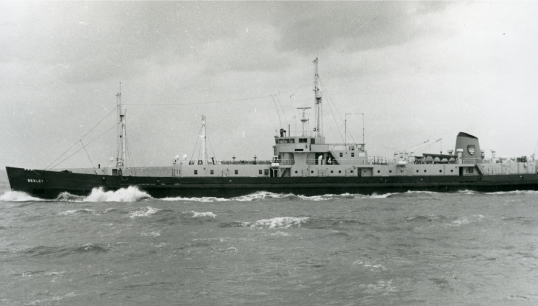Bexley

‘Bovril boats’
Known as the ‘Bovril boats’ because of the colour and consistency of their cargoes, the ships operated for more than 110 years and at their peak dumped more than 9m tonnes of sewage sludge off rivers including the Thames, Tyne, Clyde, Forth, Mersey, Solent and Humber.
Public outcry
London’s sewage sludge shipping operations began in 1887 following a Royal Commission review of the state of the Thames. This was launched in response to the public outcry over the deaths of as many as 700 passengers from the Princess Alice paddle steamer when it sank following a collision near to a raw sewage outfall at Gallions Reach in September 1878.
The inquiry concluded that the sludge removed from sewage during the treatment process should be dumped at sea to reduce the pollution of the Thames and a special fleet of six ships was built for the new trade.
For the next 111 years, the London-based sewage sludge ships would take their cargoes from Beckton and Crossness for disposal on the ebb tide at Black Deep, in the approaches to the Thames Estuary, some 12 miles off Foulness Point in Essex.
The build
Built by Dundee’s Caledon Shipbuilding & Engineering Company for the Greater London Council, the 2,432dwt Bexley was one of the last ships to operate the service. In 1974, ownership was transferred to the Thames Water Authority when it took over responsibility for London’s sewage treatment and disposal. Ownership changed again in 1990 when privatised operations began under the banner of Thames Water Utilities.
Outlawed
During the 1980s, the practice of sewage sludge dumping faced increasing opposition. Bexley was one of several vessels targeted by Greenpeace protests and the European Commission drafted a directive in 1987 which sought to bring the UK into line with other member states bordering the North Sea who had already stopped dumping.
At the end of 1998, the UK finally outlawed at-sea sewage sludge dumping – in line with European directives on urban wastewater treatment and bathing water quality. Bexley was sold to the Indian firm Tomini Shipping and switched to the Honduras flag before being broken up in Mumbai in August 2001.
Bexley fact file
How long was Bexley?
Bexley was 294.9 ft overall
What engine did Bexley have?
Bexley was powered by two six-cylinder Ruston & Hornsby ATCM6 engines
How fast was Bexley?
Bexley had a service speed of 12 knots
Contribute
Are you knowledgeable about this vessel?
Submit your contribution to this article to our editorial team.
Write to usView more ships of the past
HMS Beagle
Launched 200 years ago, HMS Beagle has been described as one of the most important ships in history – thanks to the observations on evolution and natural selection that its famous passenger Charles Darwin made during a five-year voyage around the world between 1831 and 1836.
Common.ReadMoreHMS Beagle
Oxfordshire
The Oxfordshire had a 34-year long career as an emigrant ship, passenger liner and cruiseship.
Common.ReadMoreOxfordshire
Ruahine
Entering into service just over 70 years ago, the Ruahine was the last passenger-carrying ship built for the New Zealand Shipping Company (NZSC), and the third to bear the name – which means 'wise woman' in Māori.
Common.ReadMore